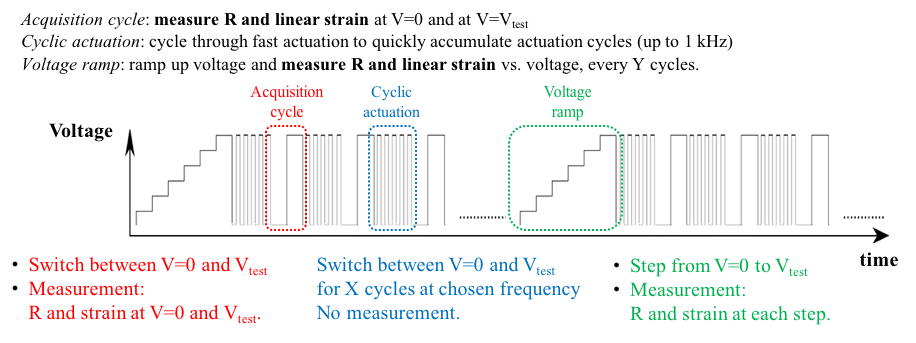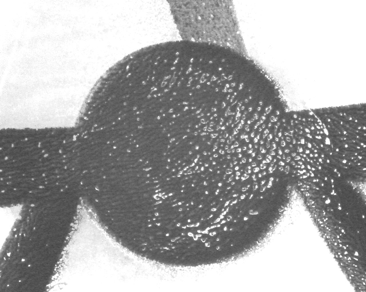Fast aging of DEA electrodes
To be used for practical applications, dielectric elastomer actuators (DEAs) must demonstrate long-term reliability. For this purpose, we developed a setup for high cycle testing of DEAs: the Novel Electrode Resistance Degradation setup i.e. the NERD setup.
Full details can be found in: “Assessing the degradation of compliant electrodes for soft actuators”, by S. Rosset,et al, Review of Scientific Instruments 88, 105002 (2017); doi: 10.1063/1.4989464
The NERD setup monitors simultaneously the linear stretch (in-plane stretch) and the electrode resistance of an expanding circle actuator (active area of approx. 10 mm2) as a function of cycle number and drive voltage. The NERD setup uses our open-source HV supply to apply high frequency (up to 1 kHz) and high voltage (up to 5 kV) square waves, making it possible to test DEA fairly rapidly over millions of cycles. The deformation of the DEA is recorded with a digital microscope and the linear stretch is calculated from the diameter change of the active zone when actuated. The four-points-probe resistance of this electrode is measured simultaneously.
The actuation profile is shown in Figure 1. Every X cycles (e.g. 2000 cycles), the linear stretch and electrode resistance at 0 V and at Vtest are measured in what is called the acquisition cycle. For each measurement the voltage is held constant for a given time (e.g. 5 s) to allow the sample to stabilize. Every Y cycles (e.g. 50,000 cycles), a voltage ramp is applied where the linear stretch and electrode resistance are measured at Z voltage levels (e.g. 8 levels) between 0 V and at Vtest. Again, the voltage is held constant for a given time (e.g. 5 s) before taking the measurement. This voltage ramp makes it possible to plot stretch vs. voltage and resistance vs. stretch every Y cycles, to evaluate the degradation of the device.

Fig 1. The three different blocks of a NERD test: the acquisition cycle blocks, the cyclic actuation blocks and the voltage ramp blocks. For each measurement the voltage is held constant for a given time to allow the sample to stabilize.
The devices for the NERD setup are depicted in Figure 2. The top and bottom electrodes are applied on a pre-stretched membrane fixed onto a support ring. The top electrode consists of a circle and four contacts to measure the 4-point resistance of the electrode. The top electrode is at ground. The bottom electrode is at a high voltage.

Fig 2: 4 mm diameter DEA used for accelerated aging tests of electrode degradation
The devices are tested over millions of cycles to reproduce the conditions encountered by devices in industrial settings. The square waveform mimics the harshest conditions by imposing a very high stretch rate (dV/dt) on the actuator. If a DEA survives this worst-case scenario, it will most probably survive milder aging conditions as well.
Using this innovative, versatile, automated setup, actuator aging tests of a million of cycles can be easily performed overnight. This tool enables DEAs’ industrial optimization to meet desired product technical specifications, but also in-depth academic understanding of their long-term behavior.
We observe very different aging characteristics for different electrodes, with carbon grease showing the shortest lifetime, and carbon-silicone composites exhibiting the longest lifetime (many millions of cycles) when tested at 5% and 10% strain.